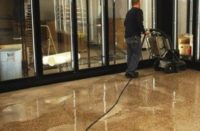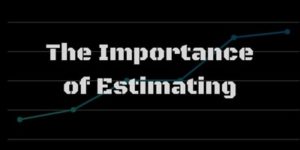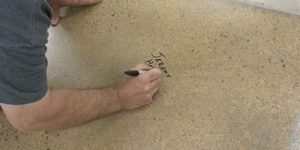Pricing a polished concrete job is hardly cut and dried. There are many things to consider. There are more obvious factors, such as labor, fuel (diesel will probably be your largest expense next to labor), tooling, and travel expenses. There are also various factors about the floor itself that must be considered. You don’t usually want to price the job by the square footage, but rather by the job.
One of the most difficult (if not the most difficult) problems in the industry is edge work. Anyone who has done any concrete polishing will tell you that there is still no good solution for edges. Oftentimes, the edge work will end up being done by hand, and it is an art in itself to learn to blend the edges in with the rest of the floor. Many contractors won’t take jobs with relatively small amounts of square footage if there will be a great deal of edge work. You definitely want to take into consideration the amount of time you will spend doing edges in relation to the square footage of the job. Also, make sure the customer understands the nature of the beast with edges, their impact on price, and what to expect as far as aesthetics. Installing epoxy on the edges is often a great alternative to polishing them, but even with epoxy, you will still have to do some light grinding on the edges and prep them.
Most existing concrete has been abused. Chips will not go away entirely unless you grind away a great deal of concrete at a great deal of expense. Concrete in poor condition will require more labor and will have more flaws. Concrete in poor condition will also be rough on your tools. These flaws won’t necessarily look bad. They are what I consider to be part of the natural element in concrete, like the natural elements in a slab of marble or granite. However, the customer needs to know exactly what to expect, and you can’t price these jobs too low.
The waviness of the concrete will very much affect the ease of polishing and the outcome of your job. Wavy concrete floors are nothing rare. Some spots will be hard to reach, and your floor will require more work to be finished and will still not have an even look at the end. Unless you have a controlled pour, let the customer know that aggregate will vary a great deal throughout the floor. Expect to see large aggregate pieces in the joints and high spots and smaller aggregate in the rest of the floor. Make sure the customer understands this before you agree to do the job. The higher your high spots, and the more you need to grind them down, the larger the visible aggregate will be in those areas. Steer away from dealing with exposed aggregate on wavy floors.
Laser-leveled concrete is much easier to polish. You can charge less for these floors. Most of the new concrete poured for industrial or commercial use now is laser-leveled. It is in renovation work that you are more likely to run into wavy floors.
Some of the concrete floors poured now are also power-troweled to the point of being overtroweled for polished concrete. Some concrete is so overtroweled that it is almost burned, and it is either extremely difficult to polish or cannot be polished. Make sure you don’t make a commitment to polish a floor that cannot be polished.
When VCT (vinyl composite tile) is taken up, it often leaves ghost lines. These lines may not go away. Your customer will need to be aware of this ahead of time.
Soft concrete will cost you more to polish than hard concrete. You should perform a hardness test before pricing any job. Soft concrete will require hard metal-bond diamond tooling. That tooling will still wear out faster, so you’ll go through more of it — in some cases, a great deal more of it. This holds true for your metal-bond and your resin-bond diamond tooling, adding cost to your job.
If your customer is requesting an exposed aggregate floor, make sure they understand the aggregate will not be evenly exposed. What already lies within the concrete, as it lies there, will be exposed. Also make sure you charge considerably more, as more labor and tooling will be required. If the concrete floor is uneven or wavy, this will become even more of an issue. If it were me, I’d have a customer sign off on such work. In today’s environment, it is wise to make sure that everyone is on the same page. You don’t want to end up in a lawsuit over unrealistic expectations. It’s always better to underpromise and overperform.
Take into consideration dust as well as possible labor expenses for cleaning. Whether a vacuum system can make concrete grinding and polishing 99 percent dust-free is questionable. There will be dust, and quite a bit of it. In a setting such as an airport, retail store, or anywhere else where the public will encounter the dust, you must make sure you minimize this issue. You may have to clean at the end of every day. Understand that the last thing the end user needs is a lawsuit, not to mention the appearance of a very dusty environment. Also make sure your employees have dust masks available to them. Concrete dust can cause silicosis.
These are all good things to keep in mind while you are pricing your first concrete polishing jobs. You will get better and better at it as you gain experience. Just as it is true that concrete polishing is an art that has to be learned with experience, pricing a polished concrete job is also an art that is learned with experience.















